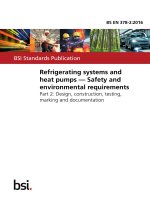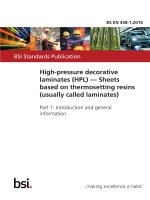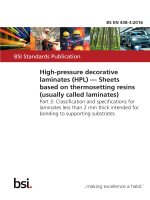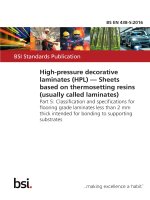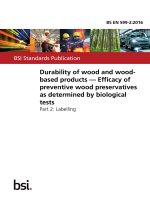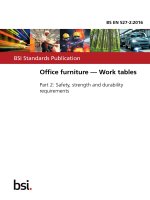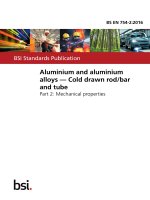Bsi bs en 00438 2 2016
Bạn đang xem bản rút gọn của tài liệu. Xem và tải ngay bản đầy đủ của tài liệu tại đây (3.29 MB, 100 trang )
BS EN 438-2:2016
BSI Standards Publication
High-pressure decorative
laminates (HPL) — Sheets
based on thermosetting resins
(usually called laminates)
Part 2: Determination of properties
BS EN 438-2:2016 BRITISH STANDARD
National foreword
This British Standard is the UK implementation of EN 438-2:2016. It
supersedes BS EN 438-2:2005 which is withdrawn.
The UK participation in its preparation was entrusted to Technical
Committee PRI/76, Laminated sheet for decorative purposes.
A list of organizations represented on this committee can be
obtained on request to its secretary.
This publication does not purport to include all the necessary
provisions of a contract. Users are responsible for its correct
application.
© The British Standards Institution 2016. Published by BSI Standards
Limited 2016
ISBN 978 0 580 87157 3
ICS 83.140.20
Compliance with a British Standard cannot confer immunity from
legal obligations.
This British Standard was published under the authority of the
Standards Policy and Strategy Committee on 29 February 2016.
Amendments issued since publication
Date Text affected
BS EN 438-2:2016
EUROPEAN STANDARD EN 438-2
NORME EUROPÉENNE
EUROPÄISCHE NORM February 2016
ICS 83.140.20 Supersedes EN 438-2:2005
English Version
High-pressure decorative laminates (HPL) - Sheets based
on thermosetting resins (usually called laminates) - Part 2:
Determination of properties
Stratifiés décoratifs haute pression (HPL) - Plaques à Dekorative Hochdruck-Schichtpressstoffplatten (HPL)
base de résines thermodurcissables (communément - Platten auf Basis härtbarer Harze (Schichtpressstoffe)
appelées stratifiés) - Partie 2: Détermination des - Teil 2: Bestimmung der Eigenschaften
propriétés
This European Standard was approved by CEN on 13 December 2015.
CEN members are bound to comply with the CEN/CENELEC Internal Regulations which stipulate the conditions for giving this
European Standard the status of a national standard without any alteration. Up-to-date lists and bibliographical references
concerning such national standards may be obtained on application to the CEN-CENELEC Management Centre or to any CEN
member.
This European Standard exists in three official versions (English, French, German). A version in any other language made by
translation under the responsibility of a CEN member into its own language and notified to the CEN-CENELEC Management
Centre has the same status as the official versions.
CEN members are the national standards bodies of Austria, Belgium, Bulgaria, Croatia, Cyprus, Czech Republic, Denmark, Estonia,
Finland, Former Yugoslav Republic of Macedonia, France, Germany, Greece, Hungary, Iceland, Ireland, Italy, Latvia, Lithuania,
Luxembourg, Malta, Netherlands, Norway, Poland, Portugal, Romania, Slovakia, Slovenia, Spain, Sweden, Switzerland, Turkey and
United Kingdom.
EUROPEAN COMMITTEE FOR STANDARDIZATION
COMITÉ EUROPÉEN DE NORMALISATION
EUROPÄISCHES KOMITEE FÜR NORMUNG
CEN-CENELEC Management Centre: Avenue Marnix 17, B-1000 Brussels
© 2016 CEN All rights of exploitation in any form and by any means reserved Ref. No. EN 438-2:2016 E
worldwide for CEN national Members.
BS EN 438-2:2016
EN 438-2:2016 (E)
Contents Page
European foreword ............................................................................................................................................................ 8
1 Scope ................................................................................................................................................................................ 9
2 Normative references ................................................................................................................................................ 9
3 Terms and definitions .............................................................................................................................................10
4 Assessment of appearance.....................................................................................................................................10
4.1 Principle.................................................................................................................................................................................. 10
4.2 Apparatus............................................................................................................................................................................... 10
4.3 Test specimen....................................................................................................................................................................... 10
4.4 Procedure............................................................................................................................................................................... 10
4.5 Test report ............................................................................................................................................................................. 11
5 Determination of thickness ...................................................................................................................................11
5.1 Principle.................................................................................................................................................................................. 11
5.2 Apparatus............................................................................................................................................................................... 11
5.3 Test specimen....................................................................................................................................................................... 11
5.4 Procedure............................................................................................................................................................................... 11
5.5 Test report ............................................................................................................................................................................. 11
6 Determination of length and width ....................................................................................................................12
6.1 Principle.................................................................................................................................................................................. 12
6.2 Apparatus............................................................................................................................................................................... 12
6.3 Test specimen....................................................................................................................................................................... 12
6.4 Procedure............................................................................................................................................................................... 12
6.5 Expression of results ......................................................................................................................................................... 12
6.6 Test report ............................................................................................................................................................................. 12
7 Determination of edge straightness...................................................................................................................12
7.1 Principle.................................................................................................................................................................................. 12
7.2 Apparatus............................................................................................................................................................................... 12
7.3 Test specimen....................................................................................................................................................................... 13
7.4 Procedure............................................................................................................................................................................... 13
7.5 Expression of results ......................................................................................................................................................... 13
7.6 Test report ............................................................................................................................................................................. 13
8 Determination of edge squareness.....................................................................................................................14
8.1 Principle.................................................................................................................................................................................. 14
8.2 Apparatus............................................................................................................................................................................... 14
8.3 Test specimen....................................................................................................................................................................... 14
8.4 Procedure............................................................................................................................................................................... 14
8.5 Expression of results ......................................................................................................................................................... 14
8.6 Test report ............................................................................................................................................................................. 14
9 Determination of flatness.......................................................................................................................................15
9.1 Principle.................................................................................................................................................................................. 15
9.2 Apparatus............................................................................................................................................................................... 15
9.3 Test specimens..................................................................................................................................................................... 15
2
BS EN 438-2:2016
EN 438-2:2016 (E)
9.4 Procedure............................................................................................................................................................................... 15
9.5 Expression of results ......................................................................................................................................................... 15
9.6 Test report ............................................................................................................................................................................. 16
10 Resistance to surface wear.................................................................................................................................16
10.1 Principle ............................................................................................................................................................................. 16
10.2 Materials ............................................................................................................................................................................ 16
10.3 Apparatus .......................................................................................................................................................................... 17
10.4 Test specimens ................................................................................................................................................................ 18
10.5 Preparation of specimens and abrasive paper................................................................................................... 19
10.6 Procedure .......................................................................................................................................................................... 19
10.6.1 Preparation of abrasive wheels ........................................................................................................................... 19
10.6.2 Calibration of abrasive paper................................................................................................................................ 19
10.6.3 Abrasion of specimen ............................................................................................................................................... 19
10.7 Expression of results..................................................................................................................................................... 20
10.8 Test report......................................................................................................................................................................... 20
11 Resistance to abrasion (flooring grade laminates)...................................................................................20
12 Resistance to immersion in boiling water....................................................................................................21
12.1 Principle ............................................................................................................................................................................. 21
12.2 Apparatus .......................................................................................................................................................................... 21
12.3 Test specimens ................................................................................................................................................................ 21
12.4 Procedure .......................................................................................................................................................................... 21
12.5 Expression of results..................................................................................................................................................... 22
12.5.1 Calculation .................................................................................................................................................................... 22
12.5.2 Surface rating scale ................................................................................................................................................... 22
12.5.3 Edge rating scale ........................................................................................................................................................ 23
12.6 Test report......................................................................................................................................................................... 23
13 Substrate protection against water vapour .................................................................................................23
13.1 Principle ............................................................................................................................................................................. 23
13.2 Apparatus .......................................................................................................................................................................... 23
13.3 Test specimens ................................................................................................................................................................ 23
13.4 Procedure .......................................................................................................................................................................... 24
13.5 Expression of results..................................................................................................................................................... 24
13.6 Test report......................................................................................................................................................................... 24
14 Resistance to water vapour ...............................................................................................................................25
14.1 Principle ............................................................................................................................................................................. 25
14.2 Apparatus .......................................................................................................................................................................... 25
14.3 Test specimen .................................................................................................................................................................. 25
14.4 Procedure .......................................................................................................................................................................... 25
14.5 Expression of results..................................................................................................................................................... 26
14.6 Test report......................................................................................................................................................................... 26
15 Resistance to wet conditions (Exterior grade laminates) ......................................................................27
15.1 Principle ............................................................................................................................................................................. 27
15.2 Apparatus .......................................................................................................................................................................... 27
15.3 Test specimens ................................................................................................................................................................ 28
15.4 Procedure .......................................................................................................................................................................... 28
15.5 Expression of results..................................................................................................................................................... 28
15.5.1 Calculation .................................................................................................................................................................... 28
15.5.2 Visual examination .................................................................................................................................................... 28
3
BS EN 438-2:2016
EN 438-2:2016 (E)
15.6 Test report......................................................................................................................................................................... 29
16 Resistance to dry heat .........................................................................................................................................29
16.1 Principle ............................................................................................................................................................................. 29
16.2 Apparatus and materials ............................................................................................................................................. 30
16.3 Test specimen .................................................................................................................................................................. 31
16.4 Test procedure................................................................................................................................................................. 31
16.5 Examination of the test specimen............................................................................................................................ 32
16.6 Expression of results..................................................................................................................................................... 32
16.7 Test report......................................................................................................................................................................... 32
17 Dimensional stability at elevated temperature .........................................................................................33
17.1 Principle ............................................................................................................................................................................. 33
17.2 Apparatus .......................................................................................................................................................................... 33
17.3 Test specimens ................................................................................................................................................................ 33
17.4 Procedure .......................................................................................................................................................................... 33
17.5 Expression of results..................................................................................................................................................... 34
17.6 Test report......................................................................................................................................................................... 34
18 Resistance to wet heat .........................................................................................................................................35
18.1 Principle ............................................................................................................................................................................. 35
18.2 Apparatus and materials ............................................................................................................................................. 35
18.3 Test specimens ................................................................................................................................................................ 36
18.4 Procedure .......................................................................................................................................................................... 36
18.5 Expression of results..................................................................................................................................................... 37
18.6 Test report......................................................................................................................................................................... 37
19 Resistance to climatic shock (exterior grade laminates) .......................................................................37
19.1 Principle ............................................................................................................................................................................. 37
19.2 Apparatus .......................................................................................................................................................................... 37
19.3 Test specimens ................................................................................................................................................................ 38
19.4 Procedure .......................................................................................................................................................................... 38
19.5 Expression of results..................................................................................................................................................... 39
19.5.1 Flexural strength and modulus of elasticity in flexure ............................................................................... 39
19.5.2 Appearance................................................................................................................................................................... 39
19.6 Test report......................................................................................................................................................................... 39
20 Resistance to impact by small-diameter ball ..............................................................................................40
20.1 Principle ............................................................................................................................................................................. 40
20.2 Materials............................................................................................................................................................................. 40
20.3 Apparatus .......................................................................................................................................................................... 40
20.4 Test specimens ................................................................................................................................................................ 43
20.5 Calibration of the impact tester................................................................................................................................ 43
20.6 Procedure .......................................................................................................................................................................... 44
20.7 Expression of results..................................................................................................................................................... 45
20.8 Test report......................................................................................................................................................................... 45
21 Resistance to impact by large diameter ball ...............................................................................................45
21.1 Principle ............................................................................................................................................................................. 45
21.2 Materials............................................................................................................................................................................. 46
21.3 Apparatus .......................................................................................................................................................................... 46
21.4 Test specimens ................................................................................................................................................................ 46
21.5 Procedure .......................................................................................................................................................................... 46
4
BS EN 438-2:2016
EN 438-2:2016 (E)
21.6 Expression of results..................................................................................................................................................... 48
21.7 Test report......................................................................................................................................................................... 49
22 Resistance to impact by large diameter ball (flooring grade laminates)..........................................49
22.1 Principle ............................................................................................................................................................................. 49
22.2 Materials ............................................................................................................................................................................ 49
22.3 Apparatus .......................................................................................................................................................................... 49
22.4 Test specimens ................................................................................................................................................................ 50
22.5 Procedure .......................................................................................................................................................................... 50
22.6 Expression of results..................................................................................................................................................... 50
22.7 Test report......................................................................................................................................................................... 50
23 Resistance to cracking under stress (laminates ≤ 2 mm thick)............................................................51
23.1 Principle ............................................................................................................................................................................. 51
23.2 Apparatus .......................................................................................................................................................................... 51
23.3 Test specimens ................................................................................................................................................................ 51
23.4 Procedure .......................................................................................................................................................................... 53
23.5 Expression of results..................................................................................................................................................... 53
23.6 Test report......................................................................................................................................................................... 54
24 Resistance to crazing (Compact laminates).................................................................................................55
24.1 Principle ............................................................................................................................................................................. 55
24.2 Apparatus .......................................................................................................................................................................... 55
24.3 Test specimens ................................................................................................................................................................ 55
24.4 Procedure .......................................................................................................................................................................... 55
24.5 Expression of results..................................................................................................................................................... 55
24.6 Test report......................................................................................................................................................................... 56
25 Resistance to scratching .....................................................................................................................................57
25.1 Principle ............................................................................................................................................................................. 57
25.2 Materials ............................................................................................................................................................................ 57
25.3 Apparatus .......................................................................................................................................................................... 57
25.4 Calibration of apparatus.............................................................................................................................................. 59
25.5 Test specimen .................................................................................................................................................................. 59
25.6 Procedure .......................................................................................................................................................................... 59
25.7 Expression of results..................................................................................................................................................... 63
25.8 Test report......................................................................................................................................................................... 63
26 Resistance to staining ..........................................................................................................................................63
26.1 Principle ............................................................................................................................................................................. 63
26.2 Staining agents ................................................................................................................................................................ 63
26.3 Apparatus and Materials ............................................................................................................................................. 65
26.4 Test specimens ................................................................................................................................................................ 66
26.5 Test procedure ................................................................................................................................................................ 66
26.6 Examination of the test panel.................................................................................................................................... 67
26.7 Assessment of results ................................................................................................................................................... 67
26.8 Test report......................................................................................................................................................................... 68
27 Light fastness (Xenon arc)..................................................................................................................................68
27.1 Principle ............................................................................................................................................................................. 68
27.2 Apparatus .......................................................................................................................................................................... 68
27.3 Test specimen .................................................................................................................................................................. 69
27.4 Procedure .......................................................................................................................................................................... 69
5
BS EN 438-2:2016
EN 438-2:2016 (E)
27.5 Assessment and expression of results ................................................................................................................... 69
27.6 Test report......................................................................................................................................................................... 70
28 Resistance to UV light (Exterior grade laminates)....................................................................................70
28.1 Principle ............................................................................................................................................................................. 70
28.2 Apparatus .......................................................................................................................................................................... 70
28.3 Test specimens ................................................................................................................................................................ 70
28.4 Procedure .......................................................................................................................................................................... 71
28.5 Evaluation and expression of results ..................................................................................................................... 71
28.5.1 General............................................................................................................................................................................ 71
28.5.2 Contrast.......................................................................................................................................................................... 71
28.5.3 Appearance................................................................................................................................................................... 71
28.6 Test report......................................................................................................................................................................... 71
29 Resistance to artificial weathering (Exterior grade laminates)...........................................................72
29.1 Principle ............................................................................................................................................................................. 72
29.2 Apparatus .......................................................................................................................................................................... 72
29.3 Test specimens ................................................................................................................................................................ 73
29.4 Procedure .......................................................................................................................................................................... 73
29.5 Examination and expression of results ................................................................................................................. 73
29.5.1 General............................................................................................................................................................................ 73
29.5.2 Contrast.......................................................................................................................................................................... 73
29.5.3 Appearance................................................................................................................................................................... 74
29.6 Test report......................................................................................................................................................................... 74
30 Determination of the microscratch resistance...........................................................................................74
30.1 Principle ............................................................................................................................................................................. 74
30.2 Terms and definitions................................................................................................................................................... 74
30.3 Apparatus and materials ............................................................................................................................................. 75
30.4 Assembly and maintenance of the Martindale tester ...................................................................................... 77
30.5 Method for checking the Lissajous figure............................................................................................................. 77
30.6 Preparation and conditioning ................................................................................................................................... 77
30.6.1 Preparation................................................................................................................................................................... 77
30.6.2 Test surface................................................................................................................................................................... 78
30.7 Test procedure................................................................................................................................................................. 78
30.7.1 General............................................................................................................................................................................ 78
30.7.2 Testing ............................................................................................................................................................................ 78
30.8 Classification of the image after scratching according to procedure B.................................................... 79
30.9 Test report......................................................................................................................................................................... 80
31 Formability (Method A) ......................................................................................................................................81
31.1 Principle ............................................................................................................................................................................. 81
31.2 Apparatus .......................................................................................................................................................................... 81
31.3 Test specimens ................................................................................................................................................................ 82
31.4 Procedure .......................................................................................................................................................................... 82
31.4.1 Calibration of test apparatus ................................................................................................................................. 82
31.4.2 Test procedure ............................................................................................................................................................ 83
31.5 Test report......................................................................................................................................................................... 84
32 Formability (Method B) ......................................................................................................................................84
32.1 Principle ............................................................................................................................................................................. 84
32.2 Apparatus .......................................................................................................................................................................... 85
32.3 Test specimens ................................................................................................................................................................ 85
6
BS EN 438-2:2016
EN 438-2:2016 (E)
32.4 Procedure .......................................................................................................................................................................... 86
32.5 Test report......................................................................................................................................................................... 87
33 Resistance to blistering (Method A) ...............................................................................................................88
33.1 Principle ............................................................................................................................................................................. 88
33.2 Apparatus .......................................................................................................................................................................... 88
33.3 Test specimens ................................................................................................................................................................ 88
33.4 Procedure .......................................................................................................................................................................... 88
33.4.1 Calibration of test apparatus................................................................................................................................. 88
33.4.2 Test procedure ............................................................................................................................................................ 88
33.5 Test report......................................................................................................................................................................... 88
34 Resistance to blistering (Method B) ...............................................................................................................89
34.1 Principle ............................................................................................................................................................................. 89
34.2 Apparatus .......................................................................................................................................................................... 89
34.3 Test specimens ................................................................................................................................................................ 89
34.4 Procedure .......................................................................................................................................................................... 89
34.4.1 General ........................................................................................................................................................................... 89
34.4.2 Calibration of test apparatus................................................................................................................................. 89
34.4.3 Test procedure ............................................................................................................................................................ 89
34.5 Test report......................................................................................................................................................................... 89
Annex A (informative) Surface finish and colour influence on surface evaluations ...............................91
Annex B (informative) Calibration and maintenance of abrasion equipment ..........................................92
B.1 General ......................................................................................................................................................................92
B.2 Apparatus.................................................................................................................................................................92
B.3 Procedure.................................................................................................................................................................92
B.3.1 Bearing Wear ......................................................................................................................................................92
B.3.2 Shaft Wear ............................................................................................................................................................92
B.3.3 Alignment .............................................................................................................................................................93
Annex C (normative) Measurement of shore A hardness ..................................................................................96
7
BS EN 438-2:2016
EN 438-2:2016 (E)
European foreword
This document (EN 438-2:2016) has been prepared by Technical Committee CEN/TC 249 "Plastics", the
secretariat of which is held by NBN.
This European Standard shall be given the status of a national standard, either by publication of an
identical text or by endorsement, at the latest by August 2016, and conflicting national standards shall be
withdrawn at the latest by August 2016.
Attention is drawn to the possibility that some of the elements of this document may be the subject of
patent rights. CEN [and/or CENELEC] shall not be held responsible for identifying any or all such patent
rights.
This document supersedes EN 438-2:2005.
EN 438, High-pressure decorative laminates (HPL) — Sheets based on thermosetting resins (usually called
laminates), consists of the following parts:
— Part 1: Introduction and general information
— Part 2: Determination of properties
— Part 3: Classification and specifications for laminates less than 2 mm thick intended for bonding to
supporting substrates
— Part 4: Classification and specifications for Compact laminates of thickness 2 mm and greater
— Part 5: Classification and specifications for flooring grade laminates less than 2 mm thick intended for
bonding to supporting substrates
— Part 6: Classification and specifications for Exterior-grade Compact laminates of thickness 2 mm and
greater
— Part 7: Compact laminate and HPL composite panels for internal and external wall and ceiling finishes
— Part 8: Classification and specifications for design laminates
— Part 9: Classification and specifications for alternative core laminates
According to the CEN-CENELEC Internal Regulations, the national standards organizations of the following
countries are bound to implement this European Standard: Austria, Belgium, Bulgaria, Croatia, Cyprus,
Czech Republic, Denmark, Estonia, Finland, Former Yugoslav Republic of Macedonia, France, Germany,
Greece, Hungary, Iceland, Ireland, Italy, Latvia, Lithuania, Luxembourg, Malta, Netherlands, Norway,
Poland, Portugal, Romania, Slovakia, Slovenia, Spain, Sweden, Switzerland, Turkey and the United
Kingdom.
8
BS EN 438-2:2016
EN 438-2:2016 (E)
1 Scope
This European Standard specifies the methods of test for determination of the properties of high-pressure
decorative laminates as defined in Clause 3. These methods are primarily intended for testing the sheets
specified in EN 438-3, EN 438-4, EN 438-5, EN 438-6, EN 438-8, and EN 438-9.
The precision of the test methods, specified in this European Standard, is not known because inter-
laboratory data are not yet available. When inter-laboratory data will be obtained, precision statements
will be added to the test method at the following revision. For those test methods having an end point
determination based on subjective judgement, it is not meaningful to make a statement of precision.
2 Normative references
The following documents, in whole or in part, are normatively referenced in this document and are
indispensable for its application. For dated references, only the edition cited applies. For undated
references, the latest edition of the referenced document (including any amendments) applies.
EN 204, Classification of thermoplastic wood adhesives for non-structural applications
EN 312, Particleboards — Specifications
EN 316, Wood fibre boards — Definition, classification and symbols
EN 438-1, High-pressure decorative laminates (HPL) — Sheets based on thermosetting resins (usually called
laminates) — Part 1: Introduction and general information
EN ISO 62, Plastics — Determination of water absorption (ISO 62)
EN ISO 178, Plastics — Determination of flexural properties (ISO 178)
EN ISO 291, Plastics — Standard atmospheres for conditioning and testing (ISO 291)
EN ISO 2813, Paints and varnishes — Determination of gloss value at 20°, 60° and 85° (ISO 2813)
EN ISO 3668, Paints and varnishes — Visual comparison of the colour of paints (ISO 3668)
EN ISO 4287, Geometrical product specifications (GPS) — Surface texture: Profile method — Terms,
definitions and surface texture parameters (ISO 4287)
EN ISO 4288, Geometrical product specifications (GPS) — Surface texture: Profile method — Rules and
procedures for the assessment of surface texture (ISO 4288)
EN ISO 4892-1, Plastics — Methods of exposure to laboratory light sources — Part 1: General guidance (ISO
4892-1)
EN ISO 4892-2:2013, Plastics — Methods of exposure to laboratory light sources — Part 2: Xenon-arc lamps
(ISO 4892-2:2013)
EN ISO 4892-3, Plastics — Methods of exposure to laboratory light sources — Part 3: Fluorescent UV lamps
(ISO 4892-3)
EN ISO 6506-1, Metallic materials — Brinell hardness test — Part 1: Test method (ISO 6506-1)
EN ISO 12945-2, Textiles — Determination of fabric propensity to surface fuzzing and to pilling — Part 2:
Modified Martindale method (ISO 12945-2)
9
BS EN 438-2:2016
EN 438-2:2016 (E)
EN ISO 12947-1, Textiles — Determination of the abrasion resistance of fabrics by the Martindale method —
Part 1: Martindale abrasion testing apparatus (ISO 12947-1)
ISO 48, Rubber, vulcanized or thermoplastic — Determination of hardness (hardness between 10 IRHD and
100 IRHD)
ISO 105-A02, Textiles — Tests for colour fastness — Part A02: Grey scale for assessing change in colour
ISO 209:2007, Aluminium and aluminium alloys — Chemical composition
ISO 1770, Solid-stem general purpose thermometers
ISO 7267-2, Rubber-covered rollers — Determination of apparent hardness — Part 2: Shore-type durometer
method
ISO 9370, Plastics — Instrumental determination of radiant exposure in weathering tests — General
guidance and basic test method
CIE 85:1989, Solar Spectral Irradiance
3 Terms and definitions
For the purposes of this document, the terms and definitions given in EN 438-1 apply.
4 Assessment of appearance
4.1 Principle
Laminates shall be inspected for surface appearance under standardised conditions of lighting and viewing.
4.2 Apparatus
4.2.1 Horizontal inspection table, of height approximately 700 mm and large enough to accommodate the
largest sheets to be inspected.
4.2.2 The light source shall provide a diffused illumination of (1200 ± 400) lx over the whole area of the
largest sheets to be inspected. This may be either diffused daylight or diffused artificial daylight.
The daylight shall be unaffected by surrounding trees, etc. When artificial daylight is used, it shall have a
correlated colour temperature of 5000 K to 6500 K. Both of them shall be in accordance with EN ISO 3668.
A convenient distance of the lights from the inspection table is approximately 1,5 m.
4.3 Test specimen
The specimen shall be the laminate under test, as supplied by the manufacturer.
4.4 Procedure
Place the laminate, decorative face uppermost, on the inspection table. Wipe it free of any loose
contamination with a soft cloth, using a suitable cleaning agent if necessary. Inspect it from the distance
required by the relevant part of EN 438 for defects such as smudges, smears, fingerprints, scratches,
foreign particles, damage or any other form of blemish evident within the decorative surface. In case of cut
to size panels of high-pressure decorative alternative core laminate(s), the inspection shall be performed
on the edges too. The evaluation of the total area of spot-type defects in square millimetres and of the total
length of hair-like defects in millimetres may be carried out with the help of the Tappi Size Estimation
10
BS EN 438-2:2016
EN 438-2:2016 (E)
Chart or with an equivalent system1). In case of dispute the inspection shall be carried out by three
observers using the Tappi Chart or an equivalent system.
The inspector shall use normal vision, corrected if necessary. In cases of doubt or dispute, three observers
shall be required for the visual assessment. All observers shall have good colour vision. In case of three
observers, the reported rating for the test surface shall be the average to the nearest nominal value.
4.5 Test report
The test report shall include the following information:
a) reference to this European Standard;
b) name, type and nominal thickness of the product;
c) size of the laminate under test;
d) viewing distance;
e) total area of spot-type defects in square millimetres;
f) total length of hair-like defects in millimetres;
g) any deviation from the specified test method;
h) date of the test.
5 Determination of thickness
5.1 Principle
The thickness of a laminate is measured using a micrometer or a dial gauge indicator.
5.2 Apparatus
Thickness gauge, (ratchet-type micrometer or dial gauge indicator), having two flat parallel measuring
surfaces of diameter 6 mm and capable of being read to 0,01 mm. When the thickness of a decorative
laminate is being measured, the two surfaces shall exert a pressure of 10 kPa to 100 kPa upon each other.
5.3 Test specimen
The specimen shall be the laminate under test, as supplied by the manufacturer.
5.4 Procedure
Check the gauge for accuracy and then determine the thickness of the laminate to the nearest 0,01 mm. The
thickness shall be measured at the centre of each edge, at a distance of at least 20 mm from the edge of the
sheet.
5.5 Test report
The test report shall include the following information:
a) reference to this European Standard;
1) Dirt size estimation chart (transparency) to evaluate the surface defects size. The chart product 0109DIRTT is recommended by
both ISO/TC 219 and CEN/TC 134, and is available from TAPPI, Technology Park, P.O. Box 105113, Atlanta, GA 30348-5113, USA,
www.tappi.org.
11
BS EN 438-2:2016
EN 438-2:2016 (E)
b) name, type and nominal thickness of the product;
c) all values measured;
d) any deviation from the specified test method;
e) date of the test.
6 Determination of length and width
6.1 Principle
Measuring the length and width of the laminate using a metal tape or rule.
6.2 Apparatus
Steel tape or rule, of sufficient length to measure the greatest dimension of the laminate, and graduated to
allow a reading accuracy of 1 mm.
6.3 Test specimen
The specimen shall be the laminate under test, as supplied by the manufacturer.
6.4 Procedure
Apply the steel tape or rule (see 6.2) to each edge of the laminate in turn, on a line approximately 25 mm
from and parallel to the edge. Measure the length on each edge to the nearest 1 mm.
6.5 Expression of results
The arithmetical means of the pairs of length and width measurements shall be calculated and expressed to
the nearest 1 mm as the length and width of the laminate.
6.6 Test report
The test report shall include the following information:
a) reference to this European Standard;
b) name, type and nominal thickness of the product;
c) length and width values;
d) any deviation from the specified test method;
e) date of the test.
7 Determination of edge straightness
7.1 Principle
Applying a metal straightedge to the edge of the laminate and measuring the deviation of the sheet edge
from the metal straightedge using a steel rule.
7.2 Apparatus
7.2.1 Metal straightedge, of 1000 mm length and having a maximum straightness deviation of 0,1 mm
over 1000 mm.
12
BS EN 438-2:2016
EN 438-2:2016 (E)
7.2.2 Steel rule, graduated in 0,5 mm divisions.
7.3 Test specimen
The specimen shall be the laminate under test, as supplied by the manufacturer.
7.4 Procedure
Apply the metal straightedge (see 7.2.1) to each edge of the laminate in turn, and use the steel rule (see
7.2.2) to measure the maximum deviation of the edge of the laminate from the metal straightedge (x in
Figure 1) to the nearest 0,5 mm
Key
1 metal straightedge
2 laminate
x maximum deviation
Figure 1 — Edge straightness measurement
7.5 Expression of results
The maximum deviation from the metal straightedge shall be recorded for each of the four edges. Results
shall be designated (+) if the edge is convex, and (-) if the edge is concave.
7.6 Test report
The test report shall include the following information:
a) reference to this European Standard;
b) name, type and nominal thickness of the product;
c) test result for each of the four edges;
d) any deviation from the specified test method;
e) date of the test.
13
BS EN 438-2:2016
EN 438-2:2016 (E)
8 Determination of edge squareness
8.1 Principle
Applying a right-angled square to the corner of the laminate and measuring the deviation of the edge from
the square using a steel rule.
8.2 Apparatus
8.2.1 Right-angled square, with one arm of at least 1000 mm long and the other arm of at least 300 mm,
having a maximum angular deviation of 0,1 mm over 1000 mm (see Figure 2).
8.2.2 Steel rule, graduated in 0,5 mm divisions.
8.3 Test specimen
The specimen shall be the laminate under test as supplied by the manufacturer.
8.4 Procedure
Apply the right-angled square (see 8.2.1) to one corner of the laminate and measure the deviation of the
edge of the laminate from the arm of the square at a distance of 1 metre from the corner. Record the results
to the nearest 0,5 mm. Repeat the procedure with the square applied to the diagonally opposite corner of
the laminate.
Dimension in millimetres
Key
1 right-angled square
2 laminate
x deviation of the edge
Figure 2 — Edge squareness measurement
8.5 Expression of results
The maximum deviation from the square shall be recorded for the two diagonally opposite corners (x in
Figure 2).
8.6 Test report
The test report shall include the following information:
a) reference to this European Standard;
14
BS EN 438-2:2016
EN 438-2:2016 (E)
b) name, type and nominal thickness of the product;
c) test result;
d) any deviation from the specified test method;
e) date of the test.
9 Determination of flatness
9.1 Principle
Measuring the bow (flatness deviation) of the laminate using a bow gauge placed at the position of greatest
deformation.
9.2 Apparatus
9.2.1 Bow gauge, of length 1 000 mm graduated to permit a reading accuracy of 0,1 mm (see Figure 3).
Dimension in millimetres
Figure 3 — Bow gauge for measuring flatness
9.3 Test specimens
The specimen shall be the laminate as supplied by the manufacturer. In cases of dispute the laminate shall
be pre-conditioned in accordance with the manufacturer’s recommendations until equilibrium is reached.
9.4 Procedure
Place the laminate concave side up without restraint on a flat horizontal surface.
Place the bow gauge (see 9.2.1) so that the three feet (two fixed and one movable) are lightly touching the
surface of the laminate in the area of greatest deformation, and measure the flatness deviation (shown on
the dial gauge) to the nearest 0,1 mm.
9.5 Expression of results
The maximum flatness deviation measured using the bow gauge shall be recorded.
15
BS EN 438-2:2016
EN 438-2:2016 (E)
9.6 Test report
The test report shall include the following information:
a) reference to this European Standard;
b) name, type and nominal thickness of the product;
c) maximum flatness deviation;
d) any deviation from the specified test method;
e) date of the test.
10 Resistance to surface wear
10.1 Principle
The test measures the ability of the decorative surface of the laminate under test to resist abrasive wear
through to the sub-layer. Abrasion is achieved by rotating a specimen in contact with a pair of loaded
cylindrical wheels covered with abrasive paper. The wheels are positioned so that their cylindrical faces
are equidistant from the specimen's axis of rotation but not tangential to it. As they are turned by the
rotating specimen they abrade an annular track on the specimen's surface. The numbers of revolutions of
the specimen required to cause defined degrees of abrasion are used as measures of resistance to surface
wear. This test is not applicable to flooring grade laminates.
10.2 Materials
10.2.1 Calibration plates of rolled zinc sheet, (Taber S-34 or equivalent), having a thickness of (0,8 ±
0,1) mm and a Brinell hardness of (48 ± 2) when tested in accordance with EN ISO 6506-1, except that the
ball diameter shall be 5 mm and the load 360 N.
The zinc plate shall not be used for more than 10 calibrations per side.
10.2.2 Abrasive paper strips, (Taber S-42 or equivalent), of width 12,7 mm and length about 160 mm,
having the following composition:
a) paper of grammage 70 g/m2 to 100 g/m2;
b) open coated 180 grit powdered aluminium oxide (Al2O3) having a particle size such that it will pass
through a sieve of aperture 100 μm and remain on a sieve having an aperture of 63 μm;
c) adhesive backing (optional).
10.2.3 Double-sided adhesive tape, required only if the abrasive paper has no adhesive backing.
10.2.4 Dirt size estimation chart (transparency), evaluate the wear through size. The chart, product
code 0109DIRTT, is recommended by both ISO/TC 219 and CEN/TC 134 and is available from TAPPI,
Technology Park, P.O. Box 105113, Atlanta, GA 30348-5113, USA, www.tappi.org.
16
BS EN 438-2:2016
EN 438-2:2016 (E)
10.3 Apparatus
10.3.1 Abrasion resistance testing machine
The test machine 2) consists of the following items, see Figure 4:
a) test specimen holder in the form of a disc (key 7) which rotates in a horizontal plane at a frequency of
58 rpm to 62 rpm and to which the test specimen (key 6) can be clamped with a clamping screw (key
5);
b) abrasive wheels (3), two cylindrical rubber-covered wheels of width (12,7 ± 0,1) mm and diameter 50
mm which rotate freely about a common axis. The curved surface of the wheels, to a depth of 6 mm,
shall be of rubber (2) of hardness (65 ± 3) IRHD when tested according to ISO 48 or (65 ± 3) Shore A
when tested according to ISO 7267-2 (see Annex C). The inside faces of the wheels shall be (52,5 ± 0,2)
mm apart and equally spaced (26,25 ± 0,10) mm from the centre-line of the abrader head and their
common axis of the wheels shall be 20 mm from the vertical axis of the test specimen holder; It is
important to ensure that the abrasive wheels are in good condition, as variations in flatness, hardness,
regularity, roundness and width can significantly affect the test result;
c) holding and lifting device (key 8), for the abrasive wheels, so constructed that each wheel exerts a force
of (5,4 ± 0,2) N on the test specimen;
d) revolution-counter;
e) suction device, so fitted that two nozzles (4) are over the abraded area of the test specimen. One nozzle
shall be situated between the wheels, the other diametrically opposite. The centres of the nozzles shall
be 77 mm apart and (2 ± 0,5) mm from the surface of the test specimen. When the nozzles are closed
there shall be a vacuum of 1,5 kPa to 1,6 kPa.
2) A suitable machine is available from Taber Acquisition Corp., Taber Industries, 455 Bryant St, P.O. Box 164, North Tonawanda,
NY 14120, USA. This test machine is an example of a suitable machine available commercially. This information is given for the
convenience of users of this European Standard and does not constitute an endorsement by CEN of the machine.
17
BS EN 438-2:2016
EN 438-2:2016 (E)
Dimension in millimetres
Key
1 abrasive paper
2 rubber
3 abrasive wheel
4 suction nozzle
5 clamping screw
6 specimen
7 specimen holder disc
8 holding and lifting device
Figure 4 — Abrasion resistance testing machine
The dimensions listed above and in Figure 4 are followed as deviations can lead to errors exceeding 100 %.
See Annex B for more information.
10.3.2 Conditioning chamber, in accordance with EN ISO 291, with a standard atmosphere of (23 ± 2) °C,
relative humidity (50 ± 5) %.
10.4 Test specimens
Each specimen shall be a piece of the laminate under test, shaped to fit the type of clamping device used. It
will usually be a disc of diameter about 130 mm, or a square of about 100 mm with its corners rounded to
18

